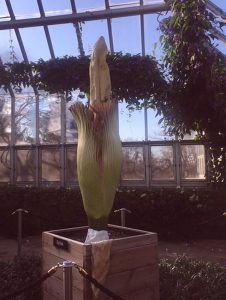
Head over to the Chicago Botanic Garden before Spike, a nearly seven-foot tall flower, is moved from the semitropical display greenhouse back to its production home on the grounds.
Called the corpse flower because of its rotting garbage odor when it blooms, Spike’s real designation is Amorphophallus titanium (titan arum).
Spike fully opened to show off its huge flower with burgundy fringe (spathe) and emitted its telltale smell on April 26.
But even though it is now closing and the odor has mostly dissipated, a bit of colorful fringe can still be seen. And, after all, a flower this tall, the largest corpse flower to bloom at the Botanic Garden, is still a site to behold.
“It certainly is something to see. You can still see the burgundy color of its spathe and then turn around and read about it in the posters,” said Botanic Garden outdoor floriculturist Tim Pollak.
“It’s never going to close tightly,” Pollak said. He thought Spike might stay on display through the weekend and possibly move on Monday or early next week.
When moved, it will go dormant then start the cycle over from having its corm (bulb) repotted to leafing out and regaining the energy needed to bloom.
“Next time it will be big, the corm will be big. This weight was over 100 pounds. Then in three to five years it may bloom again.
With Mother Nature, you don’t know. Spike did try to bloom in August, 2015 but didn’t seem to have enough energy to open.

To see what a corpse flower looks like when leafing, go next door to the tropical greenhouse. The plant looks like a tree and has a number, not a name.
“We don’t name them until they flower,” Pollak said.
Of the 14 titan arum plants in the Botanic Garden’s collection, Sprout, Sunshine, Alice, twins Sumatra and Java and Spike have been named.
However, there are relatives visitors can see when visiting the Botanic Garden such as the anthurium in the tropical greenhouse.
OK, they are not quite so big but we can get anthurium from nurseries and we can find another relative, the Jack-in-the-Pulpit, in the wild.
For more information on Spike visit CBG/Spike. For Chicago Botanic Garden parking and other information call (847) 835-5440 and visit CBS.
Enjoy
Jodie
